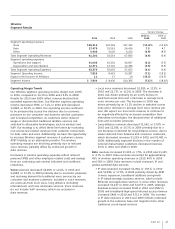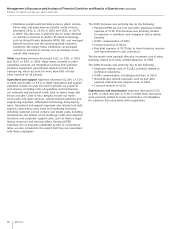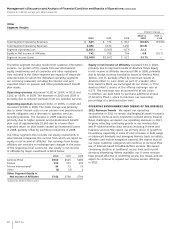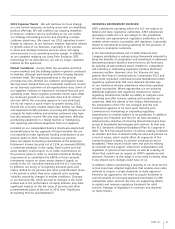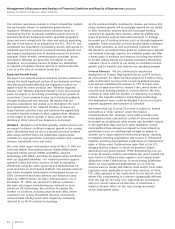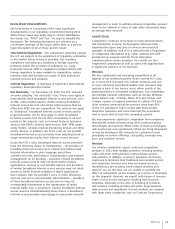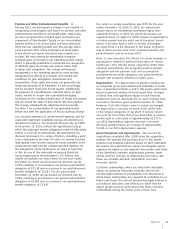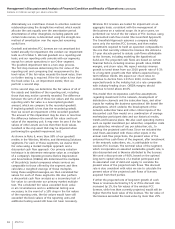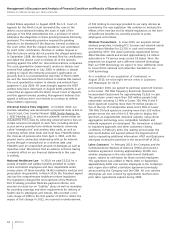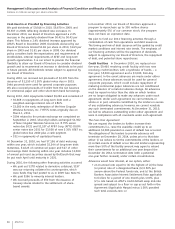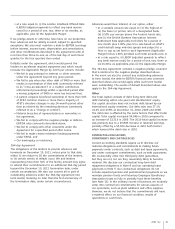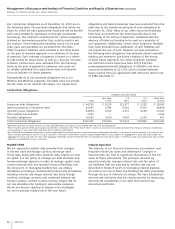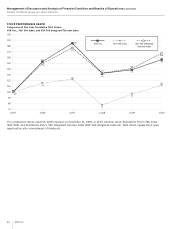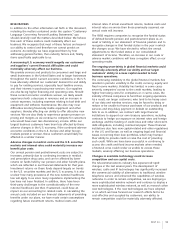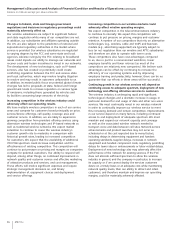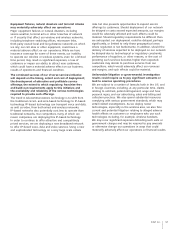AT&T Wireless 2010 Annual Report Download - page 49
Download and view the complete annual report
Please find page 49 of the 2010 AT&T Wireless annual report below. You can navigate through the pages in the report by either clicking on the pages listed below, or by using the keyword search tool below to find specific information within the annual report.
AT&T Inc. 47
requires the use of the relative selling price method as the
basis for allocation. It also significantly expands the disclosure
requirements for such arrangements, including, potentially,
certain qualitative disclosures. We adopted ASU 2009-13 for
sales entered into or materially modified in the year beginning
January 1, 2011. ASU 2009-13 had no material effect on our
financial statements or existing revenue recognition policies.
See Note 1 for a discussion of other recently issued or
adopted accounting standards.
OTHER BUSINESS MATTERS
Retiree Phone Concession Litigation In May 2005, we were
served with a purported class action in U.S. District Court,
Western District of Texas (Stoffels v. SBC Communications Inc.),
in which the plaintiffs, who are retirees of Pacific Bell Telephone
Company, Southwestern Bell and Ameritech, contend that the
cash reimbursement formerly paid to retirees living outside
their company’s local service area, for telephone service
they purchased from another provider, is a “defined benefit
plan” within the meaning of ERISA. In October 2006, the
Court certified two classes. The issue of whether the
concession is an ERISA pension plan was tried before the
judge in November 2007. In May 2008, the court ruled that
the concession was an ERISA pension plan. We asked the
court to certify this ruling for interlocutory appeal, and in
August 2008, the court denied our request. In May 2009,
we filed a motion for reconsideration with the trial court.
That motion was granted on January 14, 2011, and a final
judgment has been entered in our favor. Plaintiffs have
appealed the judgment to the Fifth Circuit Court of Appeals.
We believe that an adverse outcome having a material
effect on our financial statements in this case is unlikely,
but we will continue to evaluate the potential impact of
this suit on our financial results as it progresses.
NSA Litigation Twenty-four lawsuits were filed alleging
that we and other telecommunications carriers unlawfully
provided assistance to the National Security Agency in
connection with intelligence activities that were initiated
following the events of September 11, 2001. In the first filed
case, Hepting et al v. AT&T Corp., AT&T Inc. and Does 1-20,
a purported class action filed in U.S. District Court in the
Northern District of California, plaintiffs alleged that the
defendants disclosed and are currently disclosing to the
U.S. Government content and call records concerning
communications to which Plaintiffs were a party. Plaintiffs
sought damages, a declaratory judgment and injunctive
relief for violations of the First and Fourth Amendments
to the United States Constitution, the Foreign Intelligence
Surveillance Act (FISA), the Electronic Communications
Privacy Act and other federal and California statutes. We filed
a motion to dismiss the complaint. The United States asserted
the “state secrets privilege” and related statutory privileges
and also filed a motion asking the court to dismiss the
complaint. The Court denied the motions, and we and the
We review customer relationships and other long-lived
assets for impairment whenever events or circumstances
indicate that the carrying amount may not be recoverable
over the remaining life of the asset or asset group.
To determine that the asset is recoverable, we verify that
the expected undiscounted future cash flows directly
related to that asset exceed its book value.
We evaluate our investments to determine whether market
declines are temporary and accordingly reflected in
accumulated other comprehensive income, or other-than-
temporary and recorded as an expense in other income
(expense) in the consolidated income statements.
This evaluation is based on the length of time and the
severity of decline in the investment’s value. In 2010, we
identified an other-than-temporary decline in the value of
one of our equity method investments and various cost
investments. At the end of the first quarter of 2009 and
at the end of 2008, we concluded the severity of decline
had led to an other-than-temporary decline in the value
of assets contained in an independently managed trust
for certain BellSouth employee benefits.
Income Taxes Our estimates of income taxes and the
significant items giving rise to the deferred assets and
liabilities are shown in Note 10 and reflect our assessment
of actual future taxes to be paid on items reflected in the
financial statements, giving consideration to both timing
and probability of these estimates. Actual income taxes
could vary from these estimates due to future changes in
income tax law or the final review of our tax returns by
federal, state or foreign tax authorities.
We use our judgment to determine whether it is more
likely than not that we will sustain positions that we
have taken on tax returns and, if so, the amount of
benefit to initially recognize within our financial statements.
We regularly review our uncertain tax positions and adjust
our unrecognized tax benefits (UTBs) in light of changes
in facts and circumstances, such as changes in tax law,
interactions with taxing authorities and developments in
case law. These adjustments to our UTBs may affect our
income tax expense. Settlement of uncertain tax positions
may require use of our cash.
New Accounting Standards
Revenue Arrangements with Multiple Deliverables In
October 2009, the Financial Accounting Standards Board
(FASB) issued “Multiple-Deliverable Revenue Arrangements”
(ASU 2009-13), which addresses how revenues should be
allocated among all products and services included in our
bundled sales arrangements. It establishes a selling price
hierarchy for determining the selling price of each product
or service, with vendor-specific objective evidence at the
highest level, third-party evidence at the intermediate level,
and a best estimate at the lowest level. It eliminates the
residual method as an acceptable allocation method, and


